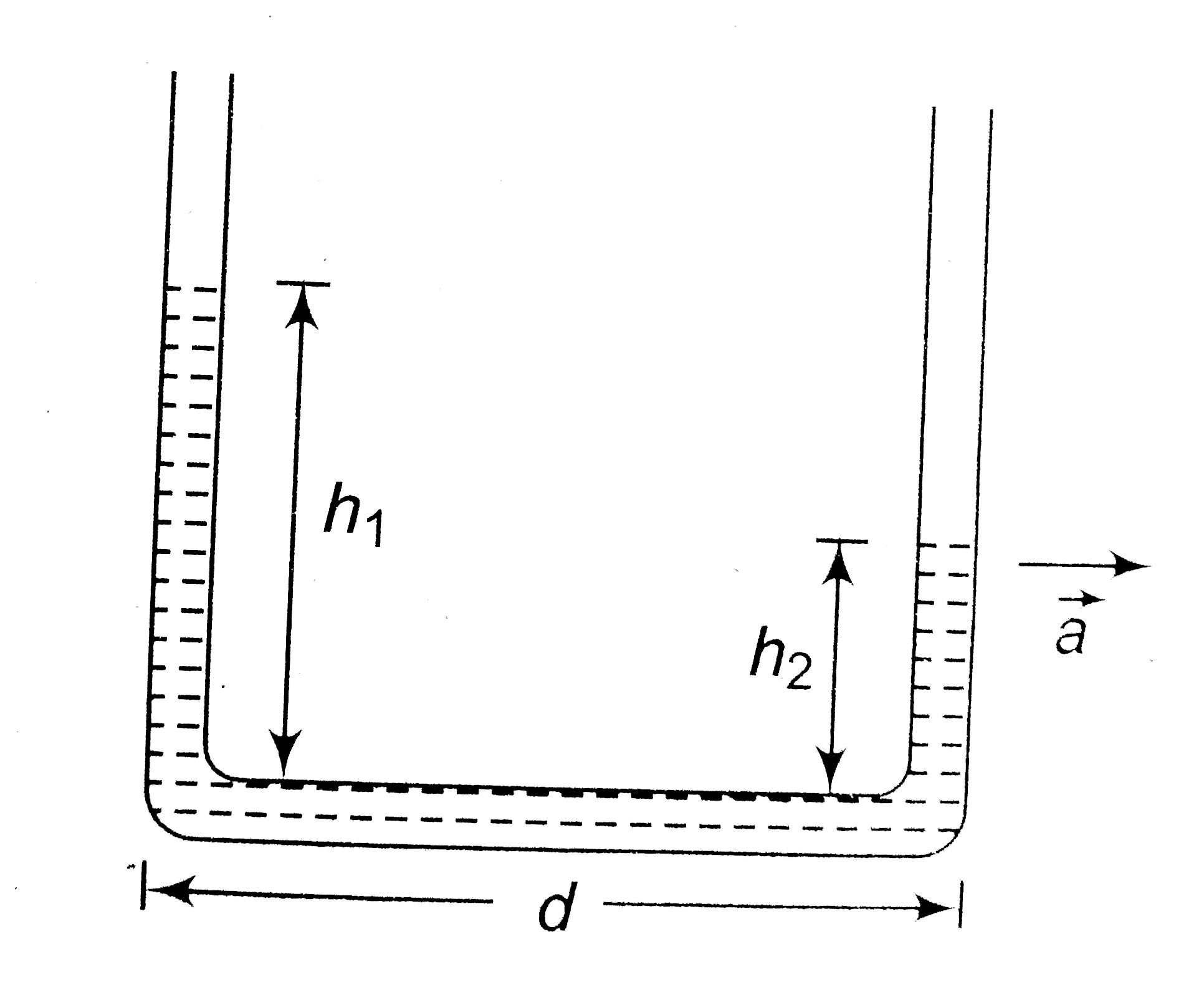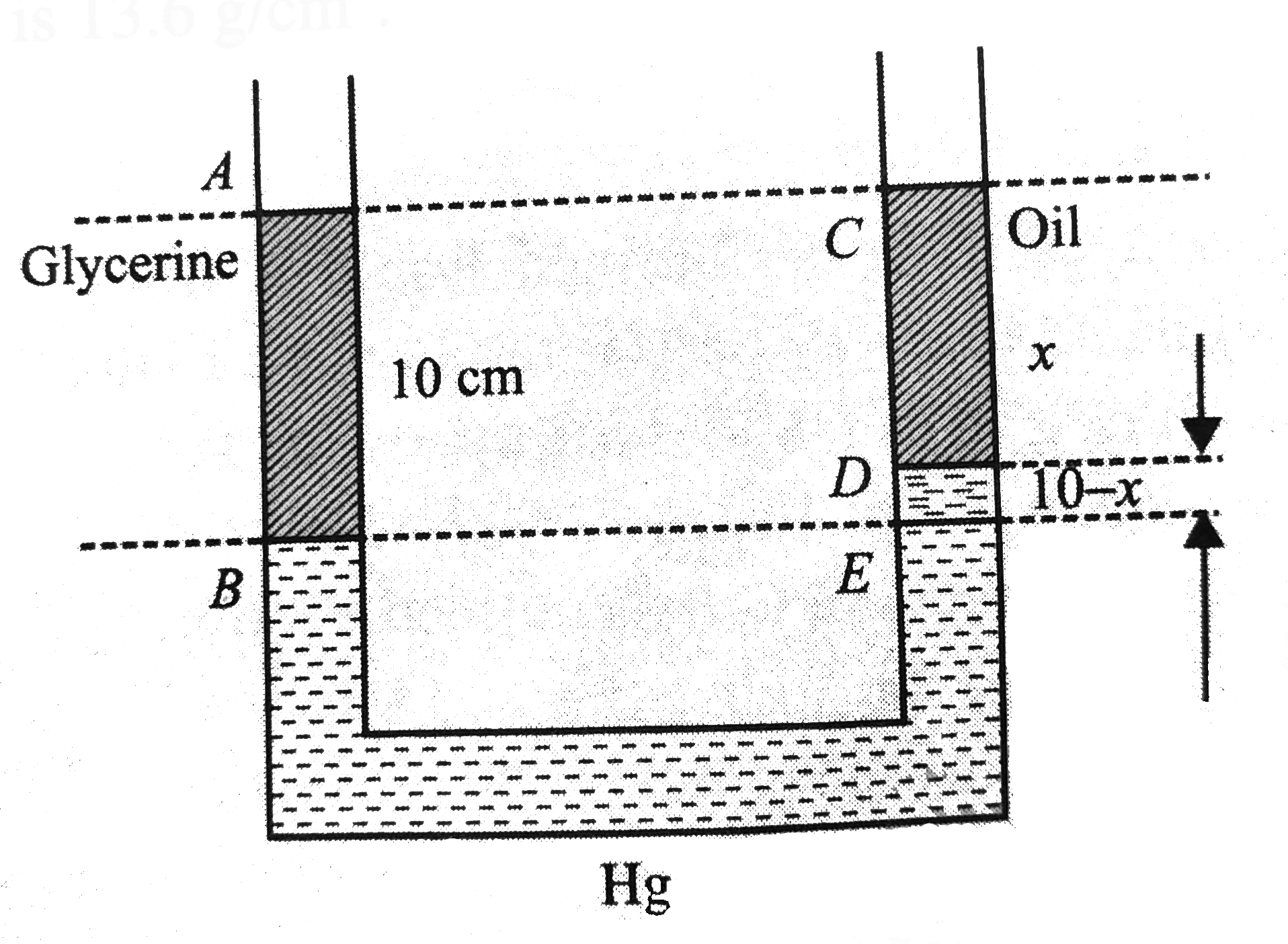An open U -tube of uniform cross-section contains mercury. When 27.2 cm of water is poured into one limb of the tube, (a) how high does the mercury rise in the limb from its initial level ? (b) what is the difference in levels of liquids of the two sides ? (ρw=1 and ρHg=13.6 units)
To solve the problem step by step, we will analyze the situation in the U-tube containing mercury and the water poured into one limb.
Step 1: Understand the Initial Conditions
Initially, the mercury levels in both limbs of the U-tube are equal. When water is poured into one limb, it exerts pressure on the mercury, causing it to rise in the other limb.
Step 2: Set Up the Pressure Equation
Let:
- H1 = height of the water column = 27.2 cm
- Y = height to which the mercury rises in the other limb from its initial level
- ρw = density of water = 1 g/cm³
- ρHg = density of mercury = 13.6 g/cm³
The pressure exerted by the water column at the depth of the mercury in the left limb must equal the pressure exerted by the mercury column in the right limb.
Using the hydrostatic pressure formula, we can write:
ρw⋅g⋅H1=ρHg⋅g⋅Y
Since g (acceleration due to gravity) is common in both sides, we can cancel it out:
ρw⋅H1=ρHg⋅Y
Step 3: Substitute the Known Values
Substituting the values we have:
1⋅27.2=13.6⋅Y
Now, solving for Y:
27.2=13.6Y
Y=27.213.6=2 cm
Step 4: Calculate the Rise in Mercury
The height to which the mercury rises in the other limb from its initial level is Y=2 cm.
Step 5: Calculate the Difference in Levels of the Liquids
The difference in levels of the liquids in the two sides can be calculated as:
ΔH=H1−2Y
Substituting the values:
ΔH=27.2−2(2)=27.2−4=23.2 cm
Final Answers
(a) The mercury rises by 2 cm in the other limb from its initial level.
(b) The difference in levels of liquids in the two sides is 23.2 cm.
Initially, the mercury levels in both limbs of the U-tube are equal. When water is poured into one limb, it exerts pressure on the mercury, causing it to rise in the other limb.
Let:
- H1 = height of the water column = 27.2 cm
- Y = height to which the mercury rises in the other limb from its initial level
- ρw = density of water = 1 g/cm³
- ρHg = density of mercury = 13.6 g/cm³
ρw⋅g⋅H1=ρHg⋅g⋅Y
Since g (acceleration due to gravity) is common in both sides, we can cancel it out:
ρw⋅H1=ρHg⋅Y
Substituting the values we have:
1⋅27.2=13.6⋅Y
Now, solving for Y:
27.2=13.6Y
Y=27.213.6=2 cm
The height to which the mercury rises in the other limb from its initial level is Y=2 cm.
The difference in levels of the liquids in the two sides can be calculated as:
ΔH=H1−2Y
Substituting the values:
ΔH=27.2−2(2)=27.2−4=23.2 cm
(a) The mercury rises by 2 cm in the other limb from its initial level.
Topper's Solved these Questions
- FLUID MECHANICSBOOK - PHYSICS GALAXY - ASHISH ARORACHAPTER - FLUID MECHANICSEXERCISE - practice Exercise 7.1
10 Videos
- FLUID MECHANICSBOOK - PHYSICS GALAXY - ASHISH ARORACHAPTER - FLUID MECHANICSEXERCISE - Practice Exercise 7.2
8 Videos
- GRAVITATIONBOOK - PHYSICS GALAXY - ASHISH ARORACHAPTER - GRAVITATIONEXERCISE - Unsolved Numerical
94 Videos
Similar Questions
A vertical uniform U tube open at both ends contains mercury. Water is poured in one limb until the level of mercury is depressed 2cm in that limb. What is the length of water column when this happens.
View SolutionA vertical U - tube of uniform cross - section contains water in both the arms. A 10 cm glycerine column (R.D. = 1.2) is added to one of the limbs. What is the level difference between the two free surface in the two limbs?
View Solution
Knowledge Check
An open U-tube contains mercury. When 11.2 cm of water is poured into one of the arms of the tube, how high does the mercury rise in the other arm from its initial level ?
A0.82 cmB1.35 cmC0.41 cmD2.32 cmA vertical U-tube contains a liquid of densityρ and surface tension T. if the radius of the meniscus of liquid in the limbs of the U-tube are R1 and R2 find the difference in the liquid column in the limbs.
AΔh=T(R1−R2)ρgR1R2BΔh=2T(R1−R2)ρgR1R2CΔh=2T(R1+R2)ρgR1R2DΔh=4T(R1−R2)ρgR1R2Fig, shows a U-tube of uniform cross-sectional area A accelerated with acceleration a as shown. If d is the seperation between the limbs. Then the difference in the levels of the liquid in the U−tube is
 AadgBgadCadgDad+g
AadgBgadCadgDad+g
A vertical U-tube of uniform cross-section contains water jn both the arms. A 10 cm glycerine column (R.D. = 1.2) is added to one of the limbs. The level difference between the two free surfaces in the two limbs wiil be
View SolutionA vertical U-tube of uniform cross-section contains water upto a height of 30 cm. show that if the water in one limb is depressed and then released, its up and down motion in the two limbs of the tube is simple harmonic and calculate its time-period.
View SolutionA thread of mercury of 10.2 g is in a tube of uniform cross-section 0.1cm2. Calculate the length of the thread. The density of mercury is 13.6gcm3.
View SolutionA U - tube of uniform cross section contains mercury upto a height h in either limb. The mercury in one limbe is depressed a little and then relased. Obtain an expression for time period (T) of oscillation, assuming that T depends on h,ρ and g, where ρ is density of mercury.
View SolutionA vertical U tube of uniform cross section contains mercury in both of its arms. A glycerine (d=1.3g/cm3) column of length 10cm is introduced into one of the arms. Oil of density 0.8g/cm3 is poured in the other arm until the upper surfaces of the oil and glycerine are in the same horizontal level. Find the length of oil column. Densit of mercury is 13.6g/cm3.

View Solution
